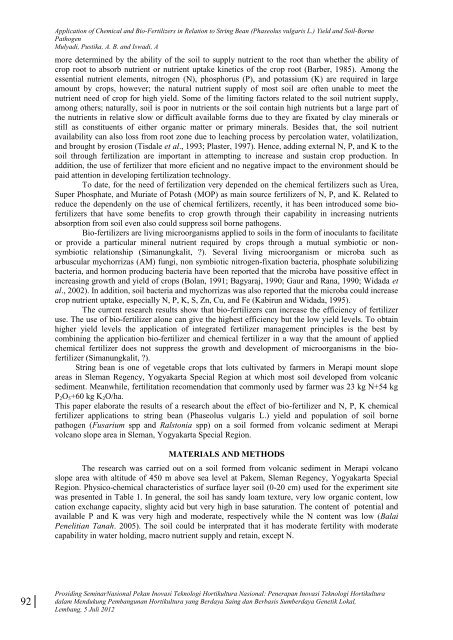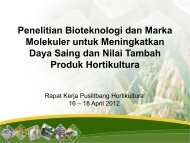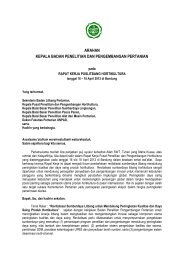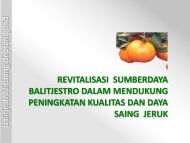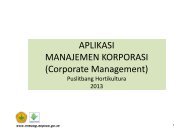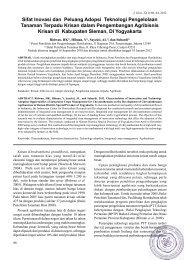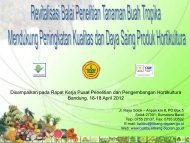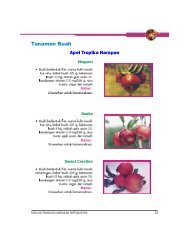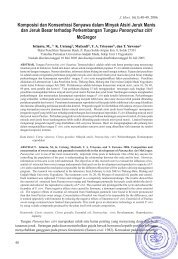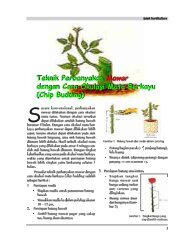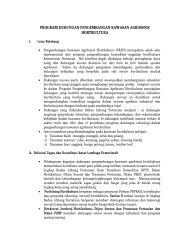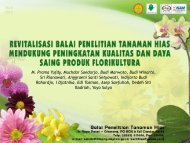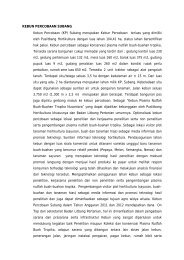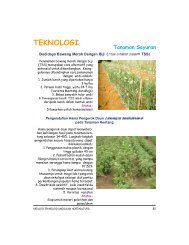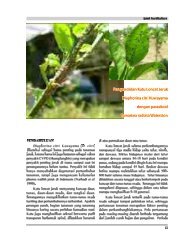SEMNAS Hortikultura Buku 2 - Departemen Pertanian
SEMNAS Hortikultura Buku 2 - Departemen Pertanian
SEMNAS Hortikultura Buku 2 - Departemen Pertanian
Create successful ePaper yourself
Turn your PDF publications into a flip-book with our unique Google optimized e-Paper software.
Application of Chemical and Bio-Fertilizers in Relation to String Bean (Phaseolus vulgaris L.) Yield and Soil-Borne<br />
Pathogen<br />
Mulyadi, Pustika, A. B. and Iswadi, A<br />
more determined by the ability of the soil to supply nutrient to the root than whether the ability of<br />
crop root to absorb nutrient or nutrient uptake kinetics of the crop root (Barber, 1985). Among the<br />
essential nutrient elements, nitrogen (N), phosphorus (P), and potassium (K) are required in large<br />
amount by crops, however; the natural nutrient supply of most soil are often unable to meet the<br />
nutrient need of crop for high yield. Some of the limiting factors related to the soil nutrient supply,<br />
among others; naturally, soil is poor in nutrients or the soil contain high nutrients but a large part of<br />
the nutrients in relative slow or difficult available forms due to they are fixated by clay minerals or<br />
still as constituents of either organic matter or primary minerals. Besides that, the soil nutrient<br />
availability can also loss from root zone due to leaching process by percolation water, volatilization,<br />
and brought by erosion (Tisdale et al., 1993; Plaster, 1997). Hence, adding external N, P, and K to the<br />
soil through fertilization are important in attempting to increase and sustain crop production. In<br />
addition, the use of fertilizer that more eficient and no negative impact to the environment should be<br />
paid attention in developing fertilization technology.<br />
To date, for the need of fertilization very depended on the chemical fertilizers such as Urea,<br />
Super Phosphate, and Muriate of Potash (MOP) as main source fertilizers of N, P, and K. Related to<br />
reduce the dependenly on the use of chemical fertilizers, recently, it has been introduced some biofertilizers<br />
that have some benefits to crop growth through their capability in increasing nutrients<br />
absorption from soil even also could suppress soil borne pathogens.<br />
Bio-fertilizers are living microorganisms applied to soils in the form of inoculants to facilitate<br />
or provide a particular mineral nutrient required by crops through a mutual symbiotic or nonsymbiotic<br />
relationship (Simanungkalit, ). Several living microorganism or microba such as<br />
arbuscular mychorrizas (AM) fungi, non symbiotic nitrogen-fixation bacteria, phosphate solubilizing<br />
bacteria, and hormon producing bacteria have been reported that the microba have possitive effect in<br />
increasing growth and yield of crops (Bolan, 1991; Bagyaraj, 1990; Gaur and Rana, 1990; Widada et<br />
al., 2002). In addition, soil bacteria and mychorrizas was also reported that the microba could increase<br />
crop nutrient uptake, especially N, P, K, S, Zn, Cu, and Fe (Kabirun and Widada, 1995).<br />
The current research results show that bio-fertilizers can increase the efficiency of fertilizer<br />
use. The use of bio-fertilizer alone can give the highest efficiency but the low yield levels. To obtain<br />
higher yield levels the application of integrated fertilizer management principles is the best by<br />
combining the application bio-fertilizer and chemical fertilizer in a way that the amount of applied<br />
chemical fertilizer does not suppress the growth and development of microorganisms in the biofertilizer<br />
(Simanungkalit, ).<br />
String bean is one of vegetable crops that lots cultivated by farmers in Merapi mount slope<br />
areas in Sleman Regency, Yogyakarta Special Region at which most soil developed from volcanic<br />
sediment. Meanwhile, fertilitation recomendation that commonly used by farmer was 23 kg N+54 kg<br />
P 2 O 5 +60 kg K 2 O/ha.<br />
This paper elaborate the results of a research about the effect of bio-fertilizer and N, P, K chemical<br />
fertilizer applications to string bean (Phaseolus vulgaris L.) yield and population of soil borne<br />
pathogen (Fusarium spp and Ralstonia spp) on a soil formed from volcanic sediment at Merapi<br />
volcano slope area in Sleman, Yogyakarta Special Region.<br />
MATERIALS AND METHODS<br />
The research was carried out on a soil formed from volcanic sediment in Merapi volcano<br />
slope area with altitude of 450 m above sea level at Pakem, Sleman Regency, Yogyakarta Special<br />
Region. Physico-chemical characteristics of surface layer soil (0-20 cm) used for the experiment site<br />
was presented in Table 1. In general, the soil has sandy loam texture, very low organic content, low<br />
cation exchange capacity, slighty acid but very high in base saturation. The content of potential and<br />
available P and K was very high and moderate, respectively while the N content was low (Balai<br />
Penelitian Tanah. 2005). The soil could be interprated that it has moderate fertility with moderate<br />
capability in water holding, macro nutrient supply and retain, except N.<br />
92│<br />
Prosiding SeminarNasional Pekan Inovasi Teknologi <strong>Hortikultura</strong> Nasional: Penerapan Inovasi Teknologi <strong>Hortikultura</strong><br />
dalam Mendukung Pembangunan <strong>Hortikultura</strong> yang Berdaya Saing dan Berbasis Sumberdaya Genetik Lokal,<br />
Lembang, 5 Juli 2012


